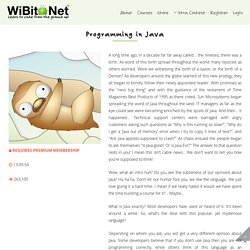

Bodytag - web programming explorations. Java Programming Cheatsheet. This appendix summarizes the most commonly-used Java language features in the textbook.

Here are the APIs of the most common libraries. Hello, World. Editing, compiling, and executing. Built-in data types. Declaration and assignment statements. Integers. Floating-point numbers. Booleans. Comparison operators. Parsing command-line arguments. Math library. The full java.lang.Math API. Type conversion. If and if-else statements. Nested if-else statement. While and for loops. Break statement. Do-while loop. Switch statement. Arrays. Compile-time initialization. Typical array-processing code. Two-dimensional arrays. Ragged arrays. Our standard output library. The full StdOut API. Our standard input library. Java Examples - Learn Java Programming by Examples. Programming in Java. A long time ago, in a decade far far away called... the nineties, there was a birth.

As word of this birth spread throughout the world many rejoiced as others worried. Were we witnessing the birth of a savior, or the birth of a Demon? As developers around the globe learned of this new prodigy, they all began to blindly follow their newly appointed leader. With promises as the "next big thing" and with the guidance of the testament of Time Magazines Best Products of 1995 as there creed, Sun Microsystems began spreading the word of Java throughout the land. IT managers as far as the eye could see were becoming enriched by the spoils of Java. Wow, what an intro huh? What is Java exactly? Depending on whom you ask, you will get a very different opinion about Java. In our Programming in Java course you will pick up where we left off with the "bold-on" Object Oriented Programming Languages and start your very first Pure OOP language.
Night School News, Videos, Reviews and Gossip - Lifehacker. Java For Beginners - Contents Page. 6.092 Introduction to Programming in Java, January IAP 2010. Elementary Cellular Automaton. The simplest class of one-dimensional cellular automata.

Elementary cellular automata have two possible values for each cell (0 or 1), and rules that depend only on nearest neighbor values. As a result, the evolution of an elementary cellular automaton can completely be described by a table specifying the state a given cell will have in the next generation based on the value of the cell to its left, the value the cell itself, and the value of the cell to its right. Since there are possible binary states for the three cells neighboring a given cell, there are a total of elementary cellular automata, each of which can be indexed with an 8-bit binary number (Wolfram 1983, 2002). ) is illustrated above. Generations of elementary cellular automaton rule are implemented as CellularAutomaton[r, , n, All, All The illustrations above show some automata numbers that give particularly interesting pattern propagated for 15 generations starting with a single black cell in the initial iteration.